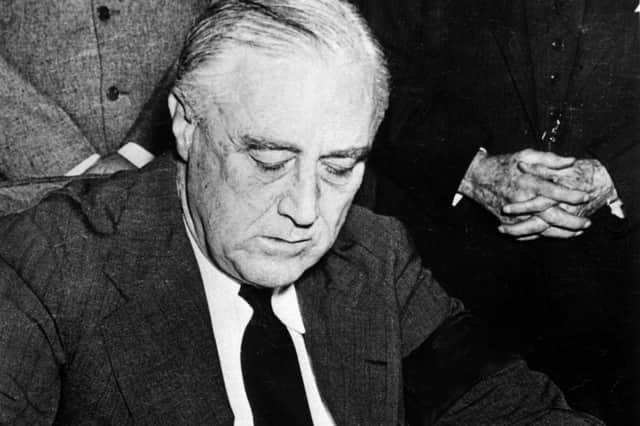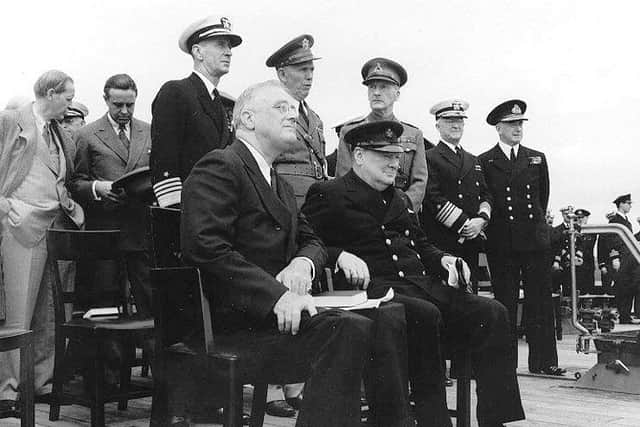WWII: How events made it easy for Roosevelt to bring a reluctant US into World War II


In the face of strong isolationist sentiment in the United States, evidenced by the existence of Charles Lindbergh’s America First Committee (which had 850,000 members and perhaps millions of sympathisers), by mid-1941 President Roosevelt had effectively committed his country to the Allied cause with a policy of ‘all aid short of war’.
When FDR and Winston Churchill met at Placentia Bay (off Newfoundland) in August 1941 Churchill pressed Roosevelt for an American declaration of war on Germany, but Roosevelt refused because he was convinced Congress would reject any attempt to bring the US into the war.
Advertisement
Hide AdAdvertisement
Hide AdRoosevelt was not being disingenuous. In May 1941 the SS Robin Moor, a US cargo vessel, was sunk by a U-boat. The U-boat allowed passengers and crew to launch her lifeboats and abandon ship with no loss of life. The reaction of American public opinion was decidedly muted.


Robert Sherwood, one of FDR’s speech writers, subsequently contextualised FDR’s refusal by explaining that ‘the tragedy of [Woodrow] Wilson was always somewhere within the rim of his [FDR’s] consciousness’, by which Sherwood meant that FDR was haunted by what happened to a president who got too far ahead of Congress and public opinion.
Churchill relayed FDR’s position to his Cabinet: ‘If he were to put the issue of peace and war to Congress, they would debate it for three months. The president had said he would wage war but not declare it, and that he would become more and more provocative. If the Germans did not like it, they could attack American forces.’
During the autumn of 1941 the United Sates slipped into an ‘undeclared war’ against Germany.
Advertisement
Hide AdAdvertisement
Hide AdOn September 4 a German U-boat torpedoed the Greer, a US destroyer that FDR claimed had been on a peaceful mail run to Iceland. Actually, the Greer had been tracking the German submarine for hours and signalling its position to the RAF which dropped depth charges on the sub, as did the Greer.
Claiming that Germany had been guilty of ‘an act of piracy’, Roosevelt used this incident to introduce naval escorts for supply convoys to the UK and instructed the US Navy to shoot U-boats ‘on sight’.
A Gallup poll in September revealed that 62% of Americans supported Roosevelt’s ‘shoot-on-sight’ order but they still wanted to stay out of the war.
Roosevelt told Lord Halifax, the British ambassador (and former British foreign secretary), that ‘his perpetual problem was to steer a course between … (1) the wish of 70% of Americans to keep out of the war [and] (2) the wish of 70% of Americans to do everything to break Hitler, even if it means war. He [Roosevelt] said that if asked for a declaration of war he wouldn’t get it, and opinion would swing against him. He therefore intended to go on doing whatever he best could do to help us, and that declarations of war were out of fashion’.
Advertisement
Hide AdAdvertisement
Hide AdOn October 31 a U-boat sank the USS Reuben James, a destroyer on convoy duty 600 miles west of Eire, killing 115 American sailors. Astonishingly opinion polls showed that the American public was still resistant to declaring war on Germany.
Despite FDR’s provocations, Hitler refused to rise to the bait and declare war on the US.
Ultimately, it was only the surprise Japanese attack on the US Pacific Fleet at Pearl Harbor on December 7 that brought America into the Second World War.
The following day Roosevelt drove to Capitol Hill to address Congress and to ask it to declare war on Japan.
Advertisement
Hide AdAdvertisement
Hide AdAlistair Cooke, the British-born journalist, witnessed the memorable scene of the disabled president moving down the aisle. ‘With infinite slowness, limping from side to side, Roosevelt came up the ramp to dais, one arm locked in his son’s, the other hand feeling every inch of the long sloping rail.’
When he reached the dais, he became a man transformed into ‘the symbol of his country’ and the familiar image of the newsreels: ‘the big-headed man, the enormous shoulders, the tolerant paternal smile, the confident hands grasping the lectern …’
He grimly told Congress: ‘Yesterday, December 7, 1941 – a date which live infamy – the United States of America was suddenly and deliberately attacked by naval and air forces of the Empire of Japan’.
He noted that ‘very many American lives’ had been lost and reported attacks on Malaya, Hong Kong, Guam, the Philippines and Wake and the Midway Islands.
Advertisement
Hide AdAdvertisement
Hide Ad‘No matter how long it may take us to overcome this premeditated invasion, the American people in their righteous might will win through to absolute victory.’
At approximately 500 words, Roosevelt’s well-crafted speech was brief and pithy and was repeatedly interrupted by applause.
The UK declared war on Japan the same day.
In a baffling decision Hitler threw caution to the wind and declared war on the United States on December 11. Italy did likewise.
Hitler and the Italians were under no obligation to come to Japan’s aid under the terms of the Tripartite Pact of September 1940 if Japan were the aggressor.
Advertisement
Hide AdAdvertisement
Hide AdHitler certainly underestimated US economic and industrial strength, despised America’s ethnic diversity and viewed her armed forces with pure contempt. (In 1941 the US could only deploy five full strength divisions compared to Hitler’s 180.)
However, Hitler solved FDR’s problem in that he did not have to ask Congress to declare war on Germany. If FDR had asked Congress to declare on Germany also when Japan was the obvious aggressor, Congressional approval might not have been forthcoming. At the very least he would have encountered some stiff opposition.
Without Hitler’s declaration Roosevelt might have been confronted with an all-out conflict with Japan when he knew that Germany was the more dangerous foe.
In late December 1941, Churchill and Roosevelt met at the Arcadia Conference in Washington DC at which both agreed on a ‘Europe first’ strategy that prioritised the defeat of Germany over Japan.